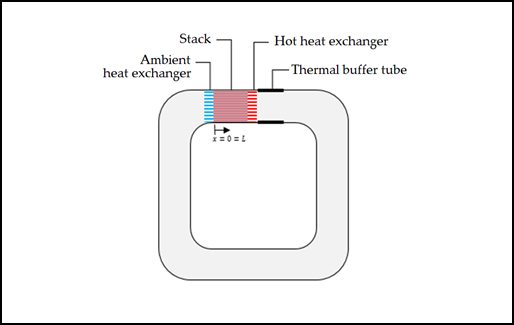Main Article Content
Abstract
The thermoacoustic engine can be a device to convert waste heat energy in the engine car become useful energy such as for charging battery in car or Air conditioner of the car. This work can be done by experimentally and numerically. There are some parameters that have an impact on the performance of the engine. They are geometry of the engines, working fluid, and mean pressure. The performance of the engine depends on the efficiency and the heating temperature. In the car, waste heat energy is not high enough. Therefore, we need to utilize the low heating temperature to be converted into useful energy. This study contributes to numerically the effect of mean pressure and loop’s radius of the regenerator on the onset temperature and the efficiency of traveling wave thermoacoustic engines. The application that is used to solve numerical problems is fortran95. There are two codings that are used in fortran95. They are stability limits and efficiency codes. The lowest onset temperature that achieved is 153˚C with efficiency up to 38.1% that can be reached when the mean pressure is 4.0 MPa and the loop's radius is 5 cm. This result indicated that we can use low heating temperatures from waste heat of engine car to turn on electronics equipment inside the car.
Keywords
Article Details

This work is licensed under a Creative Commons Attribution-NonCommercial 4.0 International License.
References
- Suharyati, S. H. Pambudi, J. L. Wibowo, and N. I. Pratiwi, “Outlook Energi Indonesia,” Jakarta, 2019.
- Government Regulation of the Republic of Indonesia Number 79 of 2014 on National Energy Policy.
- I. Setiawan, P. Murti, W. N. Achmadin, and M. Nohtomi, “Pembuatan dan Pengujian Prime Mover Termoakustik Tipe Gelombang Tegak,” in Proceeding Seminar Nasional Tahunan Teknik Mesin XIV (SNTTM XIV), 2015.
- G. A. I. Varian, “Karakteristik Termoakustik Berdasarkan Variasi,” Universitas Indonesia, 2011.
- S. W. Utami, I. Farikhah, N. Khoiri, S. Patonah, and U. Kaltsum, “Kajian Numerik Pengaruh Jari-Jari Stack terhadap Pemanasan Suhu Rendah Mesin Termoakustik Gelombang Berjalan,” in Seminar Nasional Lontar Physics Forum, 2019, pp. 23–30.
- S. W. Utami, I. Farikhah, N. Khoiri, S. Patonah, U. Kultsum, and S. Suciati, “Numerical study of the influence of radius stack on the low heating temperature and efficiency of traveling wave thermoacoustic engine,” JPhCS, vol. 1464, no. 1, p. 12012, 2020.
- I. Farikhah, “The effect of mean pressure on the performance of a single-stage heat-driven thermoacoustic cooler,” International Journal of Low-Carbon Technologies, 2020.
- I. Farikhah et al., “Thermoacoustic design using stem of goose down stack,” in AIP Conference Proceedings, 2012, vol. 1474, no. 1, pp. 283–286.
- G. W. Swift, “Thermoacoustic Engines,” Journal of Accoustical Society of America, vol. 84, no. 4, pp. 1145–1180, 1988.
- S. Backhaus and G. W. Swift, “A thermoacoustic-Stirling heat engine : Detailed study A thermoacoustic-Stirling heat engine : Detailed study,” Journal of Accoustical Society of America, vol. 107, no. 6, pp. 3148–3166, 2000.
- Y. Ueda, T. Biwa, U. Mizutani, and T. Yazaki, “Experimental studies of a thermoacoustic Stirling prime mover and its application to a cooler,” Acoustical Society of America, vol. 115, no. 3, pp. 1134–1141, 2004.
- X. Zang, J. Chang, S. Cai, and J. Hu, “A multi-stage travelling wave thermoaccoustic engine driven refigerator and operation features for utilizing low grade energy,” Energ Convers Manage, vol. 114, no. 224, p. 33, 2016.
- S. W. Utami, “Kajian Numerik Pengaruh Jari-Jari Stack Terhadap Suhu Pemanasan Rendah Dan Efisiensi Mesin Termoakustik Tipe Gelombang Berjalan,” Universitas PGRI Semarang, 2019.
- K. Rahmatunisa, “Kajian Numerik Pengaruh Panjang Dan Diameter Stack Terhadap Suhu Pemanasan Rendah Dan Efisiensi Mesin Termoakustik Tipe Gelombang Berjalan,” Universitas PGRI Semarang, 2019.
- N. Rott, “Damped and Thermally Driven Acoustic Oscillations in Wide and Narrow Tubes,” Z Angew Math Phys, vol. 20, pp. 230–243, 1969.
- T. Yazaki, A. Tominaga, and Y. Narahara, “Experiments on thermally driven acustics oscillations of gaseous helium,” Low Temperature Physics, vol. 41, pp. 45–60, 1980.
- Y. Ueda and C. Kato, “Stability analysis of thermally induced spontaneous gas oscillations in straight and looped tubes,” Journal of Accoustical Society of America, vol. 124, no. 2, pp. 851–858, 2008.
- T. Rossing, Springer handbook of acoustics. Springer Science & Business Media, 2007.
- N. Rott, “Thermally driven acoustic oscillations. Part III: Second-order heat flux,” Z angew Math Phys, vol. 26, pp. 43–49, 1975.
- I. Farikhah and Y. Ueda, “Numerical Calculation of the Performance of a Thermoacoustic System with Engine and Cooler Stacks in a Looped Tube,” Applied Sciences, vol. 7, pp. 1–14, 2017.
- T. Yazaki, T. Biwa, and A. Tominaga, “A pistonless Stirling cooler,” Applied Physics Letters, vol. 80, no. 1, 2002.
- I. Farikhah, “Optimization of a heat-driven thermoacoustic cooler in a looped tube with two stacks,” Tokyo University, 2018.
- I. Johnson, W. T. Choate, and A. Davidson, “Waste heat recovery: technology and opportunities in US Industry,” 2008.
- C. Haddad, C. Perilhon, A. Danlos, and M. X. Francois, “Some efficient solutions to recover low and medium waste heat: competitivness of the thermoacoustic technology,” in Energy Procedia, 2014, pp. 1056-1069

